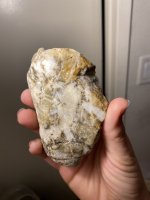uniface
Silver Member
According to this new book by University of Illinois archaeologist and professor of anthropology Tim Pauketat, the mound builders were not always the idyllic, corn-growing, pottery-making, fishing-hunting gentle villagers depicted in various dioramas at the Cahokia Mounds State Historic Site in Collinsville.
Pauketat said these long-vanished people practiced human sacrifice of women and men on a mass scale and weren't always careful to bury only the dead.
http://www.bnd.com/news/local/story/875703.html
Pauketat said these long-vanished people practiced human sacrifice of women and men on a mass scale and weren't always careful to bury only the dead.
http://www.bnd.com/news/local/story/875703.html
Upvote
0





